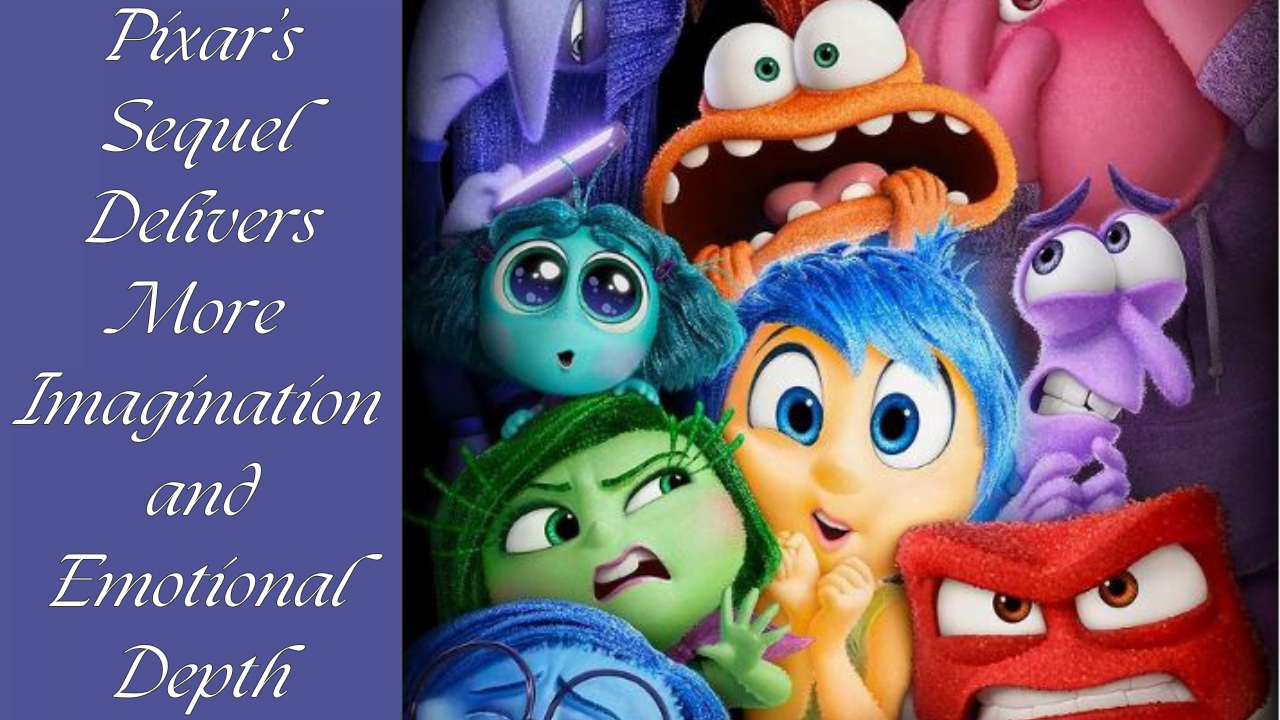Inside Out 2:

“Inside Out 2″ is an awaited sequel from Pixar, nine years after the first movie was released; hence, everything about it is highly detailed with rich imaginative brainstorming within an emotionally intelligent environment.
Table of Contents
Picking Up From Where We Left It:
“Riley is 12 now. What could possibly go wrong?” Joy asked in Pete Docter’s 2015 movie as it ended. However, the truth is that a lot could happen in-between those ages. This happens because four new emotions in Riley’s life appear towards her teenage years: Anxiety, Envy, Embarrassment, and Ennui (boredom).
It means that more characters are introduced into the movie with different color hues characterized by a sense of disorder. Consequently, “Inside Out 2” becomes more complex, creative, and hence more emotionally sophisticated.

The Introduction Of The New Emotions:
The sequel picks up immediately after the original film; it marks the directing debut of Kelsey Mann who also co-wrote its screenplay with Meg LeFauve and Dave Holstein. Although Riley’s life was smooth sailing before she was invited to try out for an ice skating team at puberty onset; things have taken a different turn since then.
At this stage of her life, she finds herself controlled by a new group of puberty-related emotions led by Anxiety -thereby relegating the old set into a jar, which gets shipped off to The Vault.’ The main characters led by Joy must fight their way back to Decisions Central and save Riley from teenage perils.
Blending Between Real and Make-Believe:
The most outstanding quality of Inside Out series is that it has this amazing ability to intertwine Pixar’s trademark fantastical adventures with the relatable pathos of coming age stories. Therefore, children’s playfulness with imagination brims beneath the surface story line about transition stages from childhood into adolescence until we are left yearning for those magical days gone by.
Every single emotion and sensation take on unique hues and personifications in terms of color. Anxiety (orange with fountain ponytail), Envy (turquoise, the tiniest), Embarrassment (got pink hooded sweater on with sweaty palms), Ennui (indigo, always slouching). Nostalgia is depicted as an old beige lady sipping tea, who is told to come back after “two graduations, and a best friend’s wedding.”
Adventures in The Vault:
While these new characters add vibrancy and complexity, the original emotions have their own adventures too. They encounter three interesting personalities while detained in the vult; a cartoon character from Riley’s childhood who cannot leave them alone, a romantic interest in the form of a Samurai video game character (who is a master of words, although he always drop his sword before it turns into a round wheel) and a huge beast symbolizing “Riley’s deepest darkest secret”.
Revisiting the Stream of Consciousness:
The sequel also revisits the Stream of Consciousness that was introduced in the first part; a literal stream through which Riley’s thoughts float away. Here, the stream within Riley’s head—her consciousness—gets more complex through signals of her cravings for junk food (pizza) as well as disgust for broccoli.
This serves as vessels for joy and her team’s exploits which also come with another challenge in the form of sar-chasm; this is a tectonic rift resulting from ennui’s introduction of sarcasm to Riley’s mind, which causes them to be in a destructive mood. Another intellectual calamity is the “Brainstorming” where colorful light bulbs fall into a tube in the control room from the sky.
Exploring the Back of the Mind:
Beyond this tube lies what Joy refers to as “the back part of the mind,” where she throws all bad memories away knowing they could eventually form core ones. This part is defined by a long chute that drains from the house to its backyard. Unbeknownst to Joy, unprocessed memories may return through this route if not properly disposed.
Besides beliefs are presented as little saplings planted with memories taking the form of seeds in the control center attached by string-line roots. This minutely detailed world has been developed over many years by the creators of “Inside Out two”, with psychologists working hand in hand with animators to tell a story that captures both imagination and deep insights into human psychology.

A Film For Every Age Group:
“Inside Out 2” got it all right, combining enough fantasy elements children would enjoy as well as various intellectual layers to keep an adult engaged Since puberty is associated with a lot of emotions from which children about to hit adolescence can quickly connect with as adults also feel similar emotions especially during the mid-life crisis.
In the first film we were told how Joy needs sadness in order to have a balanced mind. Now in the sequel Sadness becomes underrated hero while Joy remains emotional anchor point.
When Anxiety sidelines Joy, she goes into an existential crisis and first denies it before being heartbreaking “It’s growing up” is growing less joyful.” Sad but beatifully unfolding events remind us of yet another important issue pertinent to mental health: life and development are not smooth monoliths but are full of disputes. Happiness is always interspersed with other emotions rather than dominating them.
Conclusion:
This film masterfully continues Inside Out’s legacy by mixing deep emotional insights with imaginative storytelling. The insertion of new feelings adds complexity and dimensions to Riley’s character at the age she is going through, making it an interesting journey for everyone who watches this movie.
With its well developed characters, detailed world-building and thoughtful consideration of emotional health issues that concern everyone “Inside Out 2” is not only entertaining but also informative hence making it a worthy follow-up of the original work.
Thus, Pixar again proves that its’ film has been significant for different generations since youthful and elderly people would glean useful lessons from them.


4 thoughts on “Inside Out 2: Pixar’s Sequel Delivers More Imagination and Emotional Depth”